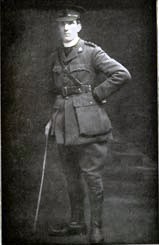05 June 1915
HELLES - THIRD BATTLE OF KRITHIA - Across all fronts at Helles on 4 June the attacks had varying success, if only initially. Especially in the British centre and on the right all began well, with two to three lines of trenches almost a kilometre wide being captured. However most of this ground had to be evacuated owing to lack of support and the failure of neighbouring attacks.
 The attack on Gully Spur was little different, but mainly due to the weakness of the artillery support, the attack also failed. With Turkish wire uncut and entrenched positions largely untouched by the bombardment, the heavy machine gun and rifle fire from the Turkish posts on both banks of Gully Ravine proved devastating to the advancing troops, whom the Turks were able to destroy with ease from behind the protection of their barbed wire. Because the Lancashire Fusilier attack failed in the middle of the Indian Brigade, this neutralised the success of the Gurkhas nearer the coast and of the 14/Sikhs in Gully Ravine. This failure on Gully Spur also affected the 88 Brigade advance east of the ravine, which found its left flank wide open and enfiladed from across the ravine. It soon became clear to all that the attack was a failure.
The attack on Gully Spur was little different, but mainly due to the weakness of the artillery support, the attack also failed. With Turkish wire uncut and entrenched positions largely untouched by the bombardment, the heavy machine gun and rifle fire from the Turkish posts on both banks of Gully Ravine proved devastating to the advancing troops, whom the Turks were able to destroy with ease from behind the protection of their barbed wire. Because the Lancashire Fusilier attack failed in the middle of the Indian Brigade, this neutralised the success of the Gurkhas nearer the coast and of the 14/Sikhs in Gully Ravine. This failure on Gully Spur also affected the 88 Brigade advance east of the ravine, which found its left flank wide open and enfiladed from across the ravine. It soon became clear to all that the attack was a failure.
Reverend Creighton on 5 June described the scene in and around Gully Ravine:
"The gully was in a perfect turmoil, of course, guns going off on all sides, and the crack of the bullets tremendously loud. They swept down the gully, and one or two men were hit. I cannot imagine anything much more blood-curdling than to go up the gully for the first time while a fierce battle is raging. You cannot see a gun anywhere, or know where the noise is coming from. At the head of the gully you simply go up the side right into the trenches. You see nothing except men passing to and fro at the bottom, and there is the incessant din overhead.
The place was very full of wounded, who were being got off on boats as quickly as possible. Everywhere, of course, I was hearing about the battle. The left had been held up, unable to advance. The centre had advanced. The casualties were heavy. The whole situation was terrible - no advance, and nothing but casualties, and the worst was that the wounded had not been got back, but lay between ours and the Turks' firing line. It was impossible to get at some of them. The men said they could see them move. The firing went on without ceasing." (Rev O. Creighton, C of E Chaplain to 86 Brigade, 29th Division).
"SOURCE:
Creighton, Reverend Oswin, CF, With the Twenty Ninth Division in Gallipoli: A Chaplain's Experience, (1916), p.121-123
